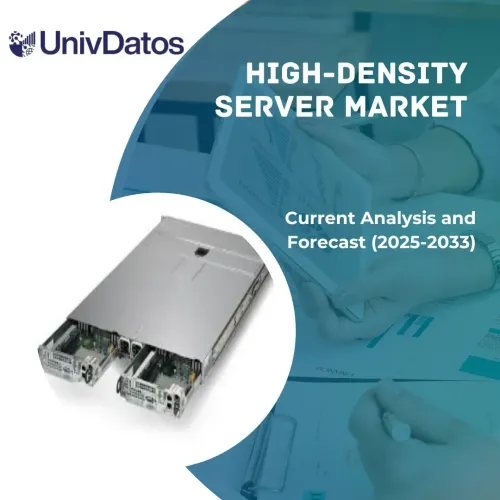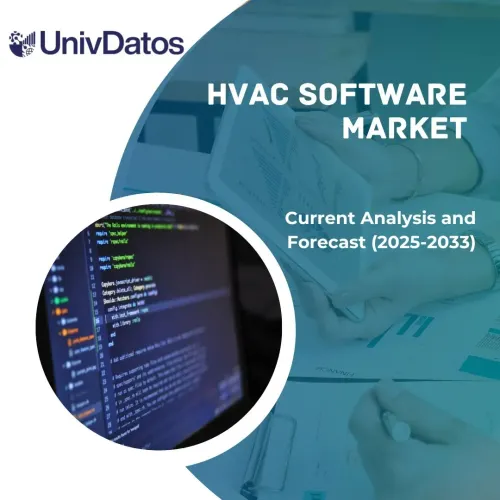- Home
- About Us
- Industry
- Services
- Reading
- Contact Us
Smart Plantation Management Systems Market: Current Analysis and Forecast (2021-2027)
Emphasis on Type (Irrigation Systems, Plant Growth Monitoring Systems, and Harvesting Systems); Crop (Coffee, Oilseeds, Sugarcane, Cotton, Fruits, Others); Component (Hardware, Software); Region/Country
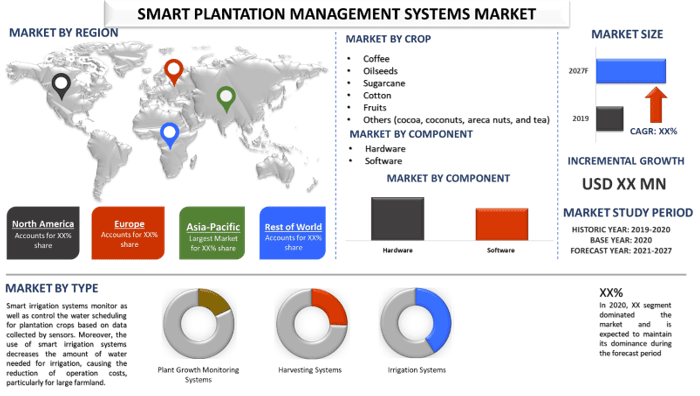
The market for smart plantation management systems was stood around $1,168 million in 2020 and is expected to showcase a significant CAGR of around 6.4% during the forecast period. Smart plantation management systems monitor the crop’s health, temperature, soil moisture, and light intensity. For instance, smart irrigation control systems help in the regulation of the water supply based on data collected by its soil moisture sensors. They cause alerts and notifications for farmers and help them in monitoring as well as tracking crop health. Smart plantations can decrease the operational costs in the larger farmlands and prevent crop failure. The demand for Smart Plantation Management Systems is increasing on account of the rise in the adoption of plantation intelligence (PI) and data mining by farmers and the decline in the wastage of resources and manpower. In addition, the rising adoption of IoT technology, cloud computing, agricultural sensors, machine learning, and smart irrigation systems in the agriculture sector is expected to create a favorable environment for the smart plantation management systems industry. Moreover, the rising number of smart plantation management systems interconnected through the internet and the cloud platform is booming the market growth. Also, the allotment of subsidiaries to farmers implementing smart farming techniques and the rising awareness about these systems is expected to positively impact the market in the forecast period. Furthermore, the high adoption of 3D laser scanning, hyper-spectral imaging, and drone-based imaging sensors interconnected through cloud platforms are anticipated to result in higher penetration of plantation intelligence.
Global Artificial Intelligence Share in Agriculture by farming type, 2019 & 2024
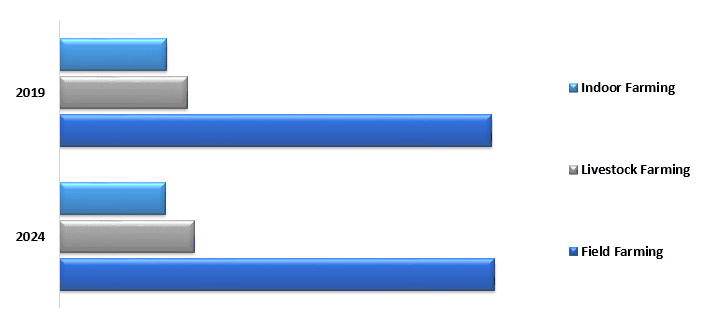
Insights Presented in the Report
“Amongst Type, Irrigation Systems segment holds the major share.”
Based on Type, the market is fragmented into Irrigation Systems, Plant Growth Monitoring Systems, and Harvesting Systems. The Irrigation Systems segment dominated the market in 2020 and is expected to grow at lucrative during the forecasted period. Smart irrigation systems monitor as well as control the water scheduling for plantation crops based on data collected by sensors. Moreover, the use of smart irrigation systems decreases the amount of water needed for irrigation, causing the reduction of operation costs, particularly for large farmland. As per the tests by the International Center for Water Technology (California) and Irrigation Association (IA), smart irrigation systems save around 20% more water than traditional irrigation systems, hence driving its demand in the market. “Amongst Crop, Fruits segment holds the major share.”
Based on Crop, the market is fragmented into Coffee, Oilseeds, Sugarcane, Cotton, Fruits, and Others (cocoa, coconuts, areca nuts, and tea). The Fruits segment dominated the market in 2020 and is expected to grow at lucrative during the forecasted period. In recent times, fruits have been emerging as a key crop for the usage of smart plantation management systems, provided the large number of players offering smart plantation systems for fruits and technologies developed for different types of fruits. Fruits such as apples, grapes, and citrus fruits are mainly used for the implementation of smart plantation management systems owing to their higher consumption. According to the Agricultural Marketing Resource Center, the most consumed fresh fruits in the U.S. are apples, oranges, grapes, and strawberries.
“Amongst Component, the Hardware segment is anticipated to grow at the highest CAGR during the analyzed period.”
Based on Component, the market is fragmented into Hardware and Software. The hardware segment holds the largest share in 2020 and is expected to register the highest CAGR in the upcoming period. The hardware component consists of several sensors, GPS devices, controllers, displays, flow meters, switches, and solenoid. Sensors are installed either on the soil or on the plants to sense and collect real-time data, which is used to produce reports and maps to assist farmers in making decisions about their crops. Sensors used are soil, water, weather, moisture, wind intensity, and temperature are mainly used in crop production. Hence, advancement in software systems intensifies the growth of hardware components.
“Asia Pacific region signifies one of the largest markets and is expected to be the fastest-growing markets of Smart Plantation Management Systems market.”
For a better understanding of the market adoption of Smart Plantation Management Systems, the market is analyzed based on its worldwide presence in the countries such as North America (United States, Canada, and the Rest of North America), Europe (Germany, France, Spain, United Kingdom and Rest of Europe), Asia-Pacific (China, Japan, India, Australia, and Rest of APAC), and Rest of World. Asia Pacific region will dominate the Smart Plantation Management Systems market on account of the rising favorable climatic conditions for plantation crops. Due to the large cultivation of different plantation crops, such as tea, sugarcane, and cotton. Some of the major players operating in the market include Robert Bosch, Deere & Company, Netafim, Synelixis Solutions, DTN, AgroWebLab Co., Ltd, SemiosBio Technologies, WaterBit, and Phytech. Several M&As along with partnerships have been undertaken by these players to boost their presence in different regions.
Reasons to buy this report:
- The study includes market sizing and forecasting analysis validated by authenticated key industry experts
- The report presents a quick review of overall industry performance at one glance
- The report covers an in-depth analysis of prominent industry peers with a primary focus on key business financials, product portfolio, expansion strategies, and recent developments
- Detailed examination of drivers, restraints, key trends, and opportunities prevailing in the industry
- The study comprehensively covers the market across different segments
- Deep dive regional level analysis of the industry
Customization Options:
The Smart Plantation Management Systems market can further be customized as per the requirement or any other market segment. Besides this, UMI understands that you may have your own business needs, hence feel free to connect with us to get a report that completely suits your requirements.
Table of Content
Analyzing the historical market, estimation of the current market, and forecasting the future market of the Global Smart Plantation Management Systems market were the three major steps undertaken to create and analyze the adoption of Smart Plantation Management Systems for the different applications across major Components such as Hardware and Software. Exhaustive secondary research was conducted to collect the historical market numbers and estimate the current market size. Secondly, to validate these insights, numerous findings and assumptions were taken into consideration. Moreover, exhaustive primary interviews were also conducted, with industry experts across the value chain of the Smart Plantation Management Systems sector. Post assumption and validation of market numbers through primary interviews, we employed a top-down/bottom-up approach to forecasting the complete market size. Thereafter, market breakdown and data triangulation methods were adopted to estimate and analyze the market size of segments and sub-segments the industry pertains to.
Detailed methodology is explained below:
Analysis of Historical Market Size
Step 1: In-Depth Study of Secondary Sources:
The detailed secondary study was conducted to obtain the historical market size of the Smart Plantation Management Systems through company internal sources such as annual reports & financial statements, performance presentations, press releases, etc., and external sources including journals, news & articles, government publications, competitor publications, sector reports, third-party database, and other credible publications.
Step 2: Market Segmentation:
After obtaining the historical market size of the Smart Plantation Management Systems market, we conducted a detailed secondary analysis to gather historical market insights and share for different segments for major regions. Major segments included in the report are Type, Crop, Component, and Region. Further country-level analyses were conducted to evaluate the overall adoption of Smart Plantation Management Systems in every region.
Step 3: Factor Analysis:
After acquiring the historical market size of different segments and sub-segments, we conducted a detailed factor analysis to estimate the current market size of Smart Plantation Management Systems. Further, we conducted factor analysis using dependent and independent variables such as rising health awareness, and the rising aging population coupled with the high prevalence of chronic diseases across different regions.
Current Market Size Estimate & Forecast
Current Market Sizing: Based on actionable insights from the above 3 steps, we arrived at the current market size, key players in the Smart Plantation Management Systems Market, and market shares of the segments. All the required percentage shares split, and market breakdowns were determined using the above-mentioned secondary approach and were verified through primary interviews.
Estimation & Forecasting: For market estimation and forecast, weights were assigned to different factors including drivers & trends, restraints, and opportunities available for the stakeholders. After analyzing these factors, relevant forecasting techniques i.e., the top-down/ bottom-up approach was applied to arrive at the market forecast about 2027 for different segments and subsegments across the major markets globally. The research methodology adopted to estimate the market size encompasses:
- The industry’s market size, in terms of value (USD) and the adoption rate of Smart Plantation Management Systems across the major markets domestically
- All percentage shares, splits, and breakdowns of market segments and sub-segments
- Key players in the Smart Plantation Management Systems market in terms of services offered. Also, the growth strategies adopted by these players to compete in the fast-growing market.
Market Size and Share Validation
Primary Research: In-depth interviews were conducted with the Key Opinion Leaders (KOLs) including Top Level Executives (CXO/VPs, Sales Head, Marketing Head, Operational Head, and Regional Head, Country Head, etc.) across major regions. Primary research findings were then summarized, and statistical analysis was performed to prove the stated hypothesis. Inputs from primary research were consolidated with secondary findings, hence turning information into actionable insights.
Split of Primary Participants in Different Regions
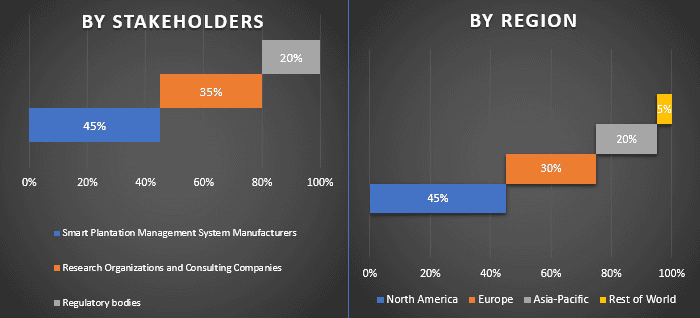
Market Engineering
Data triangulation technique was employed to complete the overall market estimation and to arrive at precise statistical numbers of each segment and sub-segment of the Smart Plantation Management Systems market. Data was split into several segments & sub-segments post studying various parameters and trends in the areas of Type, Crop, Component, and Region of the Smart Plantation Management Systems market.
Main Objective of the Smart Plantation Management Systems Market Study
The current & future market trends of Smart Plantation Management Systems were pinpointed in the study. Investors can gain strategic insights to base their discretion for investments from the qualitative and quantitative analysis performed in the study. Current and future market trends were determined the overall attractiveness of the market at a regional level, providing a platform for the industrial participant to exploit the untapped market to benefit as a first-mover advantage. Other quantitative goals of the studies include:
- Analyze the current and forecast market size of Smart Plantation Management Systems in terms of value (USD). Also, analyze the current and forecast market size of different segments and sub-segments.
- Segments in the study include areas of Type, Crop, Component, and Region
- Define and analysis of the regulatory framework for the Smart Plantation Management Systems industry
- Analyze the value chain involved with the presence of various intermediaries, along with analyzing customer and competitor behaviors of the industry
- Analyze the current and forecast market size of the Smart Plantation Management Systems market for the major region
- Major regions studied in the report include North America (the United States and Canada), Europe (Germany, France, Spain, and United Kingdom), Asia-Pacific (China, Japan, India, and Australia), and the Rest of the World
- Company profiles of the Smart Plantation Management Systems market and the growth strategies adopted by the market players to sustain in the fast-growing market
- Deep dive regional level analysis of the industry
Related Reports
Customers who bought this item also bought


